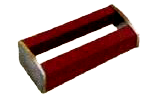Ferromagnetic material and non-magnetic material
Step-by-Step Text Solution:
1. Definition of Ferromagnetic Material:
- Ferromagnetic materials are substances that can be magnetized when placed in a magnetic field. This means that these materials can retain their magnetic properties even after the external magnetic field is removed.
- Examples of ferromagnetic materials include iron, cobalt, and nickel.
2. Characteristics of Ferromagnetic Materials:
- They have a high magnetic permeability, which means they can easily become magnetized.
- They exhibit strong magnetic properties and can be permanently magnetized.
- The magnetic domains within these materials align in the direction of the magnetic field, which contributes to their ability to retain magnetism.
3. Definition of Non-Magnetic Material:
- Non-magnetic materials are those that do not get attracted to a magnet. These materials do not exhibit any magnetic properties and cannot be magnetized.
- Examples of non-magnetic materials include wood, plastic, glass, and rubber.
4. Characteristics of Non-Magnetic Materials:
- They have low magnetic permeability, meaning they do not respond to magnetic fields.
- Non-magnetic materials do not have magnetic domains that can align with a magnetic field.
- They do not retain any magnetic properties after the removal of an external magnetic field.
Summary:
- Ferromagnetic Materials: Can be magnetized and retain magnetism (e.g., iron, cobalt).
- Non-Magnetic Materials: Cannot be magnetized and are not attracted to magnets (e.g., wood, plastic).
- Ferromagnetic materials are substances that can be magnetized when placed in a magnetic field. This means that these materials can retain their magnetic properties even after the external magnetic field is removed.
- Examples of ferromagnetic materials include iron, cobalt, and nickel.
- They have a high magnetic permeability, which means they can easily become magnetized.
- They exhibit strong magnetic properties and can be permanently magnetized.
- The magnetic domains within these materials align in the direction of the magnetic field, which contributes to their ability to retain magnetism.
- Non-magnetic materials are those that do not get attracted to a magnet. These materials do not exhibit any magnetic properties and cannot be magnetized.
- Examples of non-magnetic materials include wood, plastic, glass, and rubber.
- They have low magnetic permeability, meaning they do not respond to magnetic fields.
- Non-magnetic materials do not have magnetic domains that can align with a magnetic field.
- They do not retain any magnetic properties after the removal of an external magnetic field.
- Ferromagnetic Materials: Can be magnetized and retain magnetism (e.g., iron, cobalt).
- Non-Magnetic Materials: Cannot be magnetized and are not attracted to magnets (e.g., wood, plastic).
Topper's Solved these Questions
- MODEL TEST PAPERS BOOK - ICSECHAPTER - MODEL TEST PAPERS EXERCISE - TEST PAPER II (SECTION II) Short answer questions.
3 Videos
- MODEL TEST PAPERS BOOK - ICSECHAPTER - MODEL TEST PAPERS EXERCISE - TEST PAPER II (SECTION II) Long answer questions.
3 Videos
- MODEL TEST PAPERS BOOK - ICSECHAPTER - MODEL TEST PAPERS EXERCISE - TEST PAPER II (SECTION II) Explain the following terms with the help of examples
2 Videos
- MATTERBOOK - ICSECHAPTER - MATTEREXERCISE - Picture Based Questions
2 Videos
- PHYSICAL QUANTITIES AND MEASUREMENT BOOK - ICSECHAPTER - PHYSICAL QUANTITIES AND MEASUREMENT EXERCISE - Picture-Based Questions
1 Videos
Similar Questions
If the magnetic dipole of moment of an atom of diamagnetic material, paramagnetic material and ferromagnetic material are donated by μd,μp and μf respectively, then:
View SolutionIf the magnetic dipole of moment of an atom of diamagnetic material, paramagnetic material and ferromagnetic material are donated by μd,μp and μf respectively, then:
View Solution
Knowledge Check
Core of electromagnets are made of ferromagnetic materials which have
Alow permeability and low retentivityBhigh permeability and high retentivityChigh permeability and low retentivityDlow permeability and high retentivity.Assertion" When diamagnetic material is placed in a non-uniform magnetic Held, it tends to move from stronger to the weaker part of the magnetic field.
Reason: Diamagnetic materials possess strong magnetism.AIf both assertion and reason are true and reason is the correct explanation of assertion.BIf both assertion and reason are true and reason is not the correct explanation of assertion.CIf assertion is ture but reason is false.DIf both assertion and reason are false.

Are keepers magnetic or non-magnetic materials?
View SolutionState how magnetic susceptibility is different for the three types of magnetic materials, i.e., diamagnetic, paramagnetic and ferromagnetic materials.
View SolutionA ferromagnetic material is placed in an external magnetic field. The magnetic domains
View SolutionCore of electromagnets are made of ferromagnetic materials which have
View Solution(i) Write two characteristics of a material used for making permanaent magnets.
(ii) Why is core of an electromagnet made of ferromagnetic materials ?
View SolutionAt a certain temperature, a ferromagnetic material becomes paramagnetic. What is this temperature called ?
View Solution
